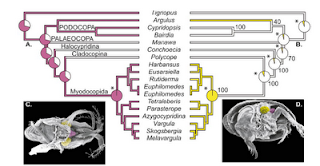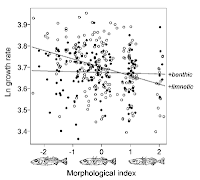Here are some examples of artistically augmented publication figures -but if you have other good examples, let me know and I'll add them:

This is from a recent Ecology Letters from Crutsinger, Cadotte (me) and Sanders (2009), 12: 285-292, trying to explain how we partitioned arthropod diversity into spatial components.

This one is from Ellwood et al. (2009) in Ecology Letters 12: 277-284, which shows co-occurrence null histograms for patterns of arthropods at various hight locations on trees.
 This one is from Crutsinger et al (2006) Science 313: 966-968 that displays patterns at differing trophic levels by juxtaposing photos of specific tropic members.
This one is from Crutsinger et al (2006) Science 313: 966-968 that displays patterns at differing trophic levels by juxtaposing photos of specific tropic members.

Finally, the use of drawings and images to illustrate phylogenetic trends in phenotypic evolution is particularly useful. Above are two examples, on the left is from Carlson et al. 2009 Evolution 63: 767-778, showing patterns of darter evolution; and on the right is from Oakley and Cunningham 2002 PNAS 99: 1426-1430, showing evolutionary pathways of compound eyes.

And here's one from Dolph Schluter (2000) American Naturalist 156: S4-S16, using drawings to illustrate how fish morphology corresponds to an abstracted index on the bottom axis.
 Here are two from Joe Baily while working in Tom Whitham's Cottonwood Ecology Group that are effective ways to remind the reader what the treatments or dependent variables were (elk herbivory, leaf shape/genotype) and what the response variables were (bird predation, wood consumption by beavers). The left hand figure is from Baily & Whitham (2003) Oikos 101: 127-134 and the one on the right is from Baily et al. (2004) Ecology 85: 603-608.
Here are two from Joe Baily while working in Tom Whitham's Cottonwood Ecology Group that are effective ways to remind the reader what the treatments or dependent variables were (elk herbivory, leaf shape/genotype) and what the response variables were (bird predation, wood consumption by beavers). The left hand figure is from Baily & Whitham (2003) Oikos 101: 127-134 and the one on the right is from Baily et al. (2004) Ecology 85: 603-608.Here is a great one posted by Ethan on Jabberwocky Ecology on Hurlbert's Unicorn!
